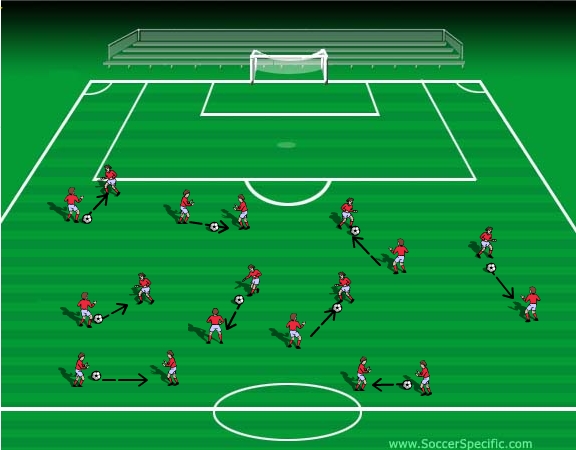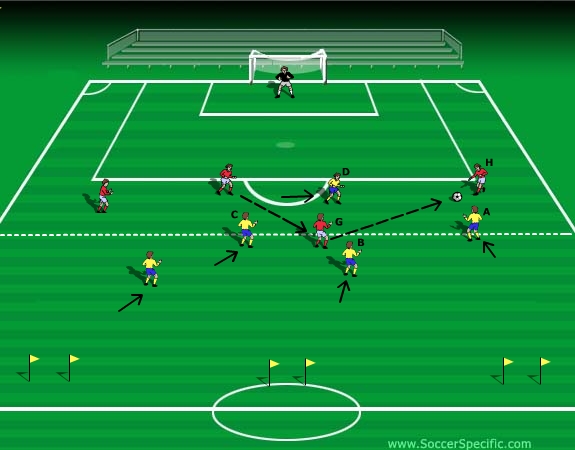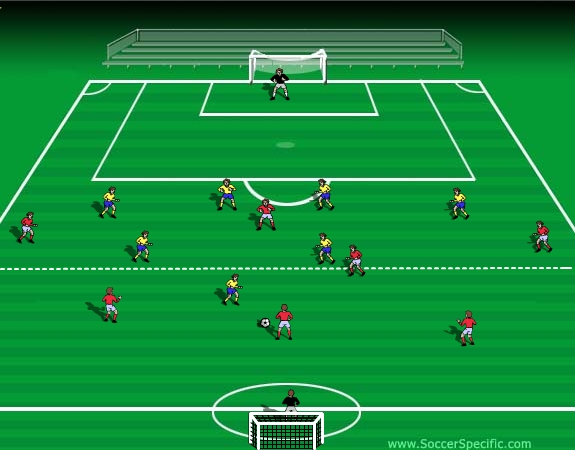Ronan Wiseman is currently an Assistant Coach at Adelphi University in Long Island, New York. He has professional coaching experience having been the Head Coach of Long Island of the US 1st Division (A-League) from ´03 – ´05.
He is a former professional player, having played for the Long Island franchise in the A-League for 6 years.
Ronan holds a USSF ‘A’ License.
Pressure: When, Where and How as a Unit in the Attacking 1/3
Activity #1: Warm Up
Set Up:
Players move on a half pitch with a partner as shown below. Partners pass and move freely.

Explanation:
Players pass and move – on coaches command – one player sprints to “pressure” his opponent. This pressure can be passive at first and progress to full pressure as the warm-up continues.
Coaching Points:
- Speed of pressure.
- Angle of pressure.
- Tenacity to win ball.
Activity #2: 5v5 Game
Set Up:
One team has 5 field players (Yellow): the other team has 4 field players and a goalkeeper (Red) as shown below. Three mini-goals are created using flags as shown.

Explanation:
Play starts with a pass from the goalkeeper to any of his teammates. Emphasis is placed on the defensive shape and responsibilities of the “defensive” (Yellow) team. The “attacking” team (Red above) must attempt to score in any of the three mini-goals near the half-way line.
If the “defensive” team gains possession of teh ball they must attack quickly and attempt to score in the full-size goal. Play is continuous until a goal is scored.
In the Diagram above, the “defensive” unit has adjusted their positions to try to win the ball – Player (A) is forcing the play inside; Player (B) has stepped to ball-side on Red (G). Players (C) and (D) have moved to confine the playing area.
The 4 “attacking” players get the ball on every re-start.
Coaching Points:
- Defensive team must work as a “UNIT”
- Communicate at all times.
- “Read the Game” – try to intercept passes etc.
- Move as the ball moves – positioning in relation to teammates, opponents, ball.
- Speed of connter-attack after winning possession.
- Use the man advantage to maintain possession if a quick counter-attack is not possible.
Activity #3: 7v7 + Goalkeepers
Set Up:
Two-thirds of a pitch is used as the playing area. A half-way line is created using cones. Two teams of 7 players are organised within the playing area as shown below.

Explanation:
Play starts with a pass to the Yellow attacking team. One team is designated as the “attacking” team (Yellow above) and the other team is designated as the “defending ” team (Red above). Both teams compete for possession of the ball and attempt to score in their opponents goal. The offside law is in effect. Emphasis is placed on the defensive responsibilities and shape of the Red team.
The “defensive” team are encouraged to create pressure areas / pockets in certain areas of the pitch in order to win possession of the ball.
All re-starts go to the Yellow “attacking” team.
See Diagram (d) below – the Red “defensive” team has created a “pressure pocket” on one side of the pitch making it very difficult for the Yellow team to maintain possession – this may force a turn-over in an advanced area of the pitch.
Player (A) has stepped to put immediate pressure on the ball as well as force the opponent inside towards the pressure; Players (B) and (C) have stepped to the ball-side shoulder of their opponents in anticipation of intercepting any potential pass. Player (D) has moved to deny a passing option for the wide Yellow player. Players (E), (F), (G) have all adjusted their positions to squeeze the space and make the pitch more compact while still providing adequate cover and balance.
Progression:
Have the players play “low pressure” at first and switch to “pressing” at coaches command or on certain visual cues – bad pass, back-pass to goalkeeper etc. This can help develop an understanding of the right moments to apply pressure and in what areas.
Coaching Points:
- Move as a “UNIT”
- Communicate at all times.
- Read the game – anticipate the play.
- Counter-Attack quickly if possible.
- Force the attacking team into tight areas – dictate what the opponents do!
